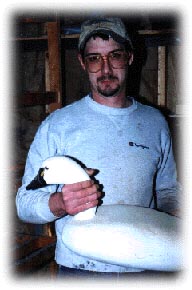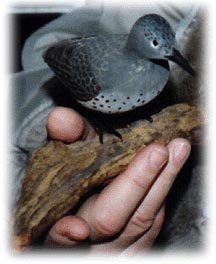  by Clayton Davis
George Bell of Crisfield, Maryland is sensitive to the shape and plumage of
migratory waterfowl that visit his home.
Dangling down from Pennsylvania is a huge leaf shape that shields the
Chesapeake Bay from the cold, vicious Atlantic Ocean. It is called the
Delmarva Peninsula, occupied in thirds by Delaware, Maryland and Virginia,
hence the name. Geese and other migratory wildfowl find this a splendid
route to take north and south as they live out nature's plan for their
annual vacation.
"I can tell you something about decoys used for hunting," says George.
"They are carved from Cottonwood. Autumn is the time of year when we look
for the perfect Cottonwood tree. That is when the leaves are gone and the
sap is down. It is the best time to cut one for decoy carving."
George was born twenty-six years ago in Shelltown, eight miles east of
Crisfield along the Pocomoke Sound. He carries on a unique carving
tradition started by the Ward Brothers in Crisfield many years ago.
Making a living on the bay as a waterman for five years, George decided
there must be something else he could do and started sanding decoys for
Zack Ward, a relative of the Ward Brothers. He has been carving on his own
for ten years now.
The first thing George ever carved was a swan decoy. He was 16. It was a
thing he says is so ugly he'll probably own it for the rest of his life.
While sanding for Zack Ward, George picked up customers when his boss
couldn't fill the orders.
"Feel it," George says as he hands me a decoy. "Almost light as a
feather. Cottonwood floats."
For many, the Chesapeake Bay provides a living from the sea but catching it will freeze your
hands and have you sloshing hip-deep in bay water. It is, George concludes, "Much more
interesting to carve waterfowl decoys."
1/25/98 |

 George told his story so well I could see a splendid Cottonwood tree
standing alone in a forest. I saw it felled, the wood carved into the
shape of beautiful ducks and geese.
George told his story so well I could see a splendid Cottonwood tree
standing alone in a forest. I saw it felled, the wood carved into the
shape of beautiful ducks and geese.
 Lem and Steve Ward had transformed the decoy from a hunter's tool to a work of
art, and taught their carving techniques to anyone who would drop by and
chat a spell. In tribute to their contribution, the Ward Foundation was
established in 1968. It now claims 6000 members in 13 countries. The Ward
Museum of Wildfowl Art was erected to preserve their legacy in 1992. It
sits alongside Schumaker Pond in Salisbury, Maryland, where wildfowl swim
and play in their natural habitat.
Lem and Steve Ward had transformed the decoy from a hunter's tool to a work of
art, and taught their carving techniques to anyone who would drop by and
chat a spell. In tribute to their contribution, the Ward Foundation was
established in 1968. It now claims 6000 members in 13 countries. The Ward
Museum of Wildfowl Art was erected to preserve their legacy in 1992. It
sits alongside Schumaker Pond in Salisbury, Maryland, where wildfowl swim
and play in their natural habitat.
 George has lived in Crisfield for the past 10 years, just a mile from the famous Ward Brothers
workshop.
George has lived in Crisfield for the past 10 years, just a mile from the famous Ward Brothers
workshop.
 A dozen hunting ducks usually takes George about five days to carve and
paint. A decorative decoy will take up to three days. People place orders
anywhere from 6 months to a year ahead of time. The price for a typical
decoy is about one hundred dollars, although it really depends on the
type. He once made a full size standing eagle that sold for a thousand
dollars. George's carving styles are derived from the patterns created by
Lem and Steve Ward, obtained through his association with Zack.
A dozen hunting ducks usually takes George about five days to carve and
paint. A decorative decoy will take up to three days. People place orders
anywhere from 6 months to a year ahead of time. The price for a typical
decoy is about one hundred dollars, although it really depends on the
type. He once made a full size standing eagle that sold for a thousand
dollars. George's carving styles are derived from the patterns created by
Lem and Steve Ward, obtained through his association with Zack.
 The best decoys are carved from the heart of a cottonwood tree. "We cut
them when the sap is down," George says. "Cut them into blocks about two
or three feet long. The blocks cure in the attic all next summer." When
the wood is thoroughly dry and cured, George will carve three or four
decoys from each block.
The best decoys are carved from the heart of a cottonwood tree. "We cut
them when the sap is down," George says. "Cut them into blocks about two
or three feet long. The blocks cure in the attic all next summer." When
the wood is thoroughly dry and cured, George will carve three or four
decoys from each block.